
Cluster Creation on Websphere Application Server
Oracle Banking Enterprise Limits and Collateral
Management
Release 14.5.1.0.0
[June] [2021]

Table of Contents
1. PURPOSE ....................................................................................................................................................................... 1-1
2. INTRODUCTION TO WEBSPHERE ......................................................................................................................... 2-1
3. PRE-REQUISITES: ...................................................................................................................................................... 3-1
4. STEPS INVOLVED FOR CLUSTERING .................................................................................................................. 4-1
4.1 CREATE PROFILE ...................................................................................................................................................... 4-1
4.1.1 Create Deployment Manager Profile ............................................................................................................... 4-5
4.2 CREATE NODE ........................................................................................................................................................ 4-13
4.2.1 Start Node Agents .......................................................................................................................................... 4-16
4.3 CREATE CLUSTER ................................................................................................................................................... 4-16
4.3.1 Add Cluster Members .................................................................................................................................... 4-18
4.3.2 Start Cluster ................................................................................................................................................... 4-20
4.4 CREATE PROXY SERVER ......................................................................................................................................... 4-21
4.4.1 Start Proxy Server .......................................................................................................................................... 4-24
4.5 CONFIGURE VIRTUAL HOST .................................................................................................................................... 4-25
4.5.1 Virtual Host Setup .......................................................................................................................................... 4-26
5. CREATE RESOURCES IN CLUSTER SCOPE ........................................................................................................ 5-1
6. DEPLOY APPLICATION TO CLUSTER ................................................................................................................. 6-1
6.1.1 Test the application .......................................................................................................................................... 6-2

1.Purpose
This document explains steps to create Cluster on Websphere Application Server 8.5 and also setup the
proxy.

2.Introduction to Websphere
IBM websphere application server cluster deployment contains the below key elements
Cell
Nodes
o Deployment Manager Node- “DMGR”
o Node- “NodeXX”
o Node Agent- “NAXX”
Profiles
Cluster
Cluster Members
Data Sources
Profile

2-2
Cell: A cell is a grouping of nodes into a single administrative domain. In a Network Deployment environment,
a cell can consist of multiple nodes (and node groups), which are all administered from a single point, the
deployment manager.
Node: A node is an administrative grouping of application servers for configuration and operational
management within one operating system instance
Node Agent: In distributed server configurations, each node has a node agent that works with the deployment
manager to manage administration processes. A node agent is created automatically when you add
(federate) a stand-alone node to a cell.
Cluster: A cluster is a logical collection of application server processes that provides workload balancing and
high availability. Application servers that belong to a cluster are members of that cluster and must all have
identical application components deployed on them.
A profile is a Websphere runtime environment formed by collection of User data and Product files. Product
Files are shared application binaries for Websphere. User data is set of user customizations for a specific
runtime environment.
Prominent profile types are:
o Stand-alone Application Server: An application server environment runs Enterprise Application.
Application server is managed from its own administrative console and functions independently from
other application server.
o Deployment Manager: A Deployment Manager manages operations for a logical group or cell of other
servers. It is the central administration point of a cell that consists of multiple nodes and node groups
in a distributed server configuration. The deployment manager uses the node agent to manage the
application servers within one node. A deployment manager provides management capability for
multiple federated nodes and can manage nodes that span multiple systems and platforms. A node
can only be managed by a single deployment manager and must be federated to the cell of that
deployment manager.
Note ** Deployment Manager is part of Network Deployment Edition of Websphere.

3. Pre-requisites:
Before proceeding with the cluster setup ensure that the below resources are created
JDBC Provider
Datasource
Queue Connection Factory
JMS Queue
The instructions for resource creation are available in document
<installer>\Docs\WEBSPHERE\Resource_Creation_WAS.doc
For SSL configuration in Websphere, refer to the document SSL_Configuration_WAS.doc
For application deployment, refer to document FCUBS_Application_WAS.doc
For deployment of Gateway applications, refer to document GATEWAY_Applications_WAS.doc

4. Steps involved for Clustering
4.1 Create Profile
Go to Profile Management Tool
Navigation: IBM WebSphere > IBM WebSphere Application Server V8.5 > Tools > Profile Management
Tool
Navigation : Profile Management Tool > Create

4-2
Navigation : Application Server > Next
Navigation : Typical profile creation > Next

4-3
Navigation: Enable administrative security > Next
Navigation : Create Summary

4-4
Navigation : Finish
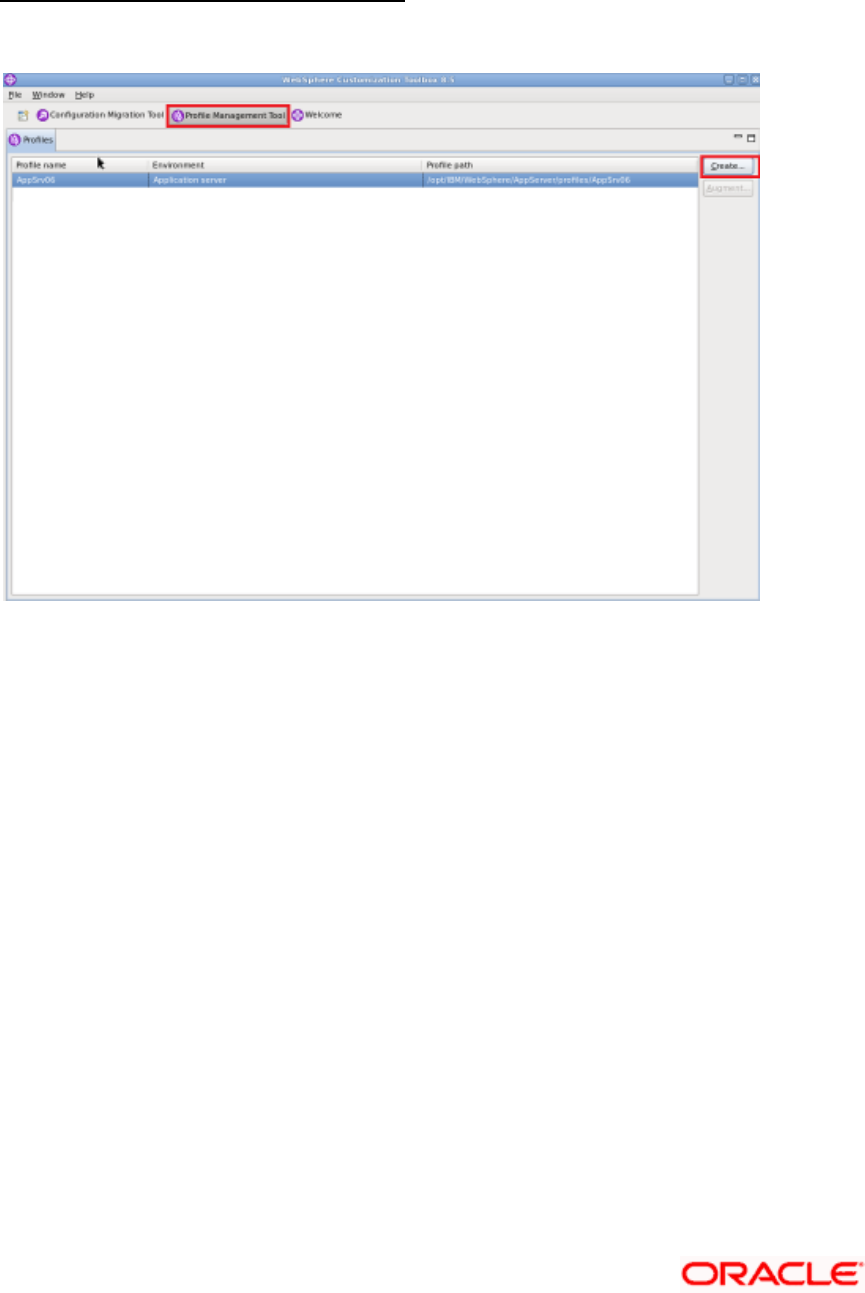
4-5
4.1.1 Create Deployment Manager Profile
Navigation : Profile Management Tool > Create
Navigation : Management >Next

4-6
Navigation : Deployment Manager > Next
Navigation: Typical profile creation > Next

4-7

4-8
Navigation: Enable administrative security > Next

4-9
Navigation : Create

4-10
Start Deployment Manager & Open Administrative Console
Navigation : IBM WebSphere > IBM WebSphere Application Server V8.5 > Profiles > Dmgr[i]>Start the
deployment manager > Administrative console

4-11
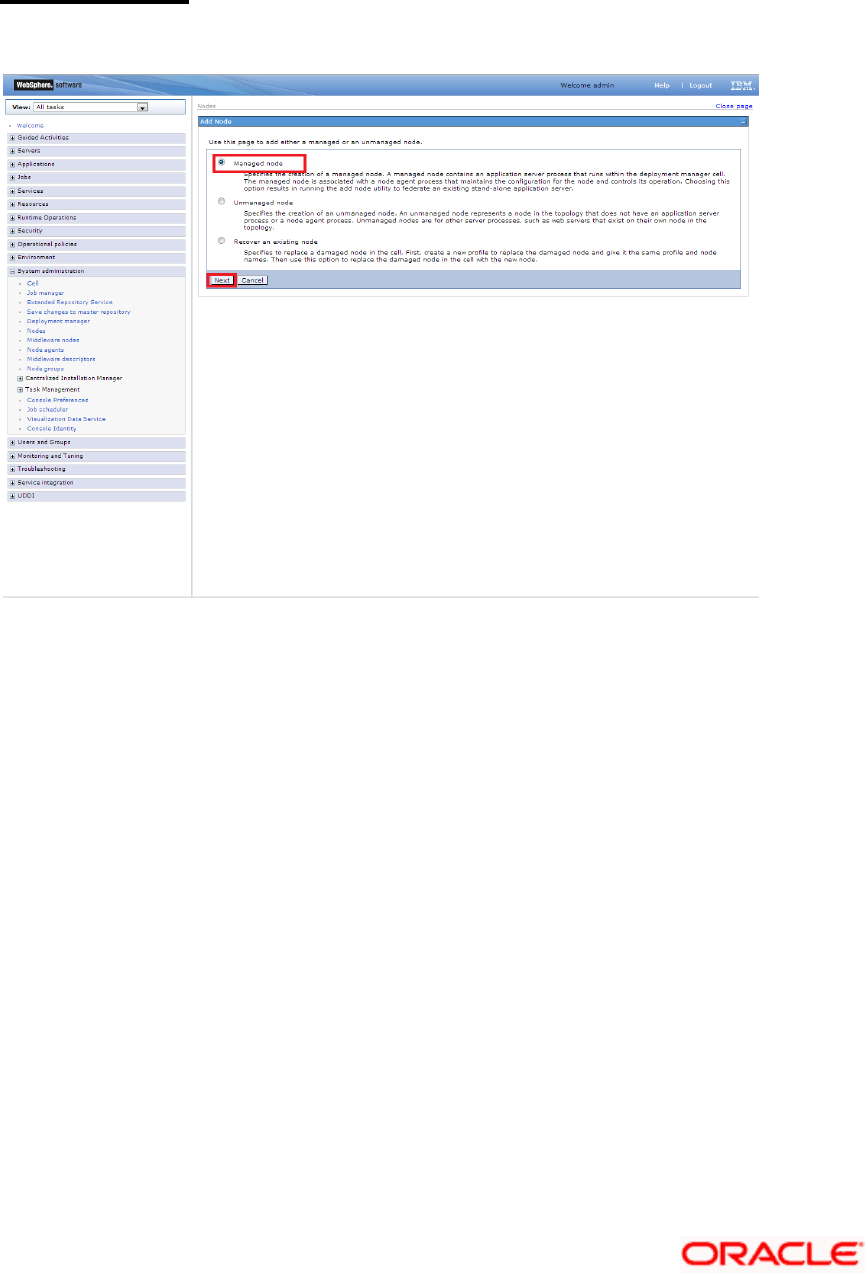
4-13
4.2 Create Node
Navigation : System administration > Nodes > Add Node
Provide the following field information and Click ‘OK’
Host : Host Machine with running Application Server
JMX Connector type : SOAP
JMX Connector Port : SOAP_CONNECTOR_ADDRESS of Application Server
Application server user name : Application server user id
Application server password : Application server password
Deployment manager user name : Deployment manager user id
Deployment manager password : Deployment manager password

4-14

4-15
Create necessary number of nodes following same instructions above:

4-17

4-18
4.3.1 Add Cluster Members
Add required number of cluster members
Navigation : Add Member > Next

4-19
Navigation : Next
Navigation : Finish
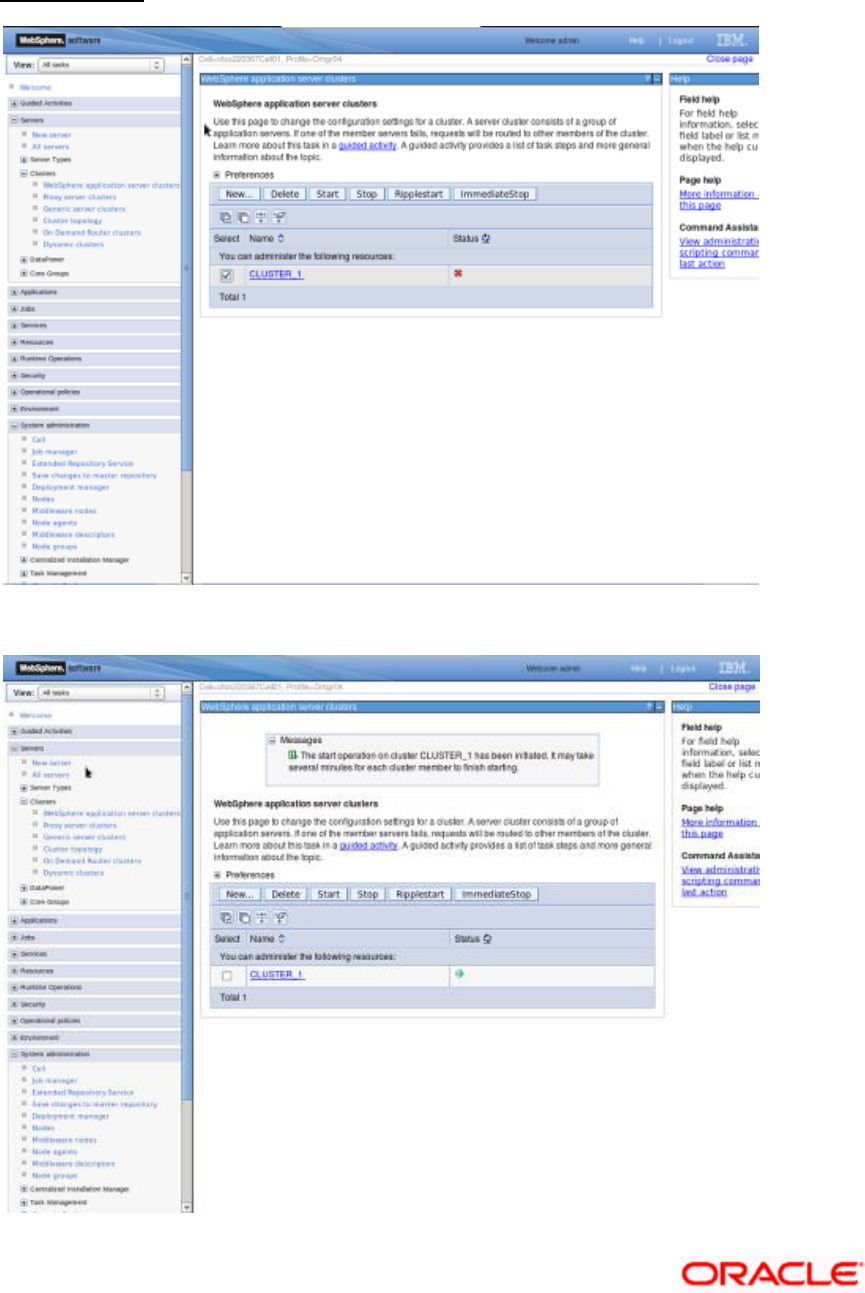
4-20
4.3.2 Start Cluster
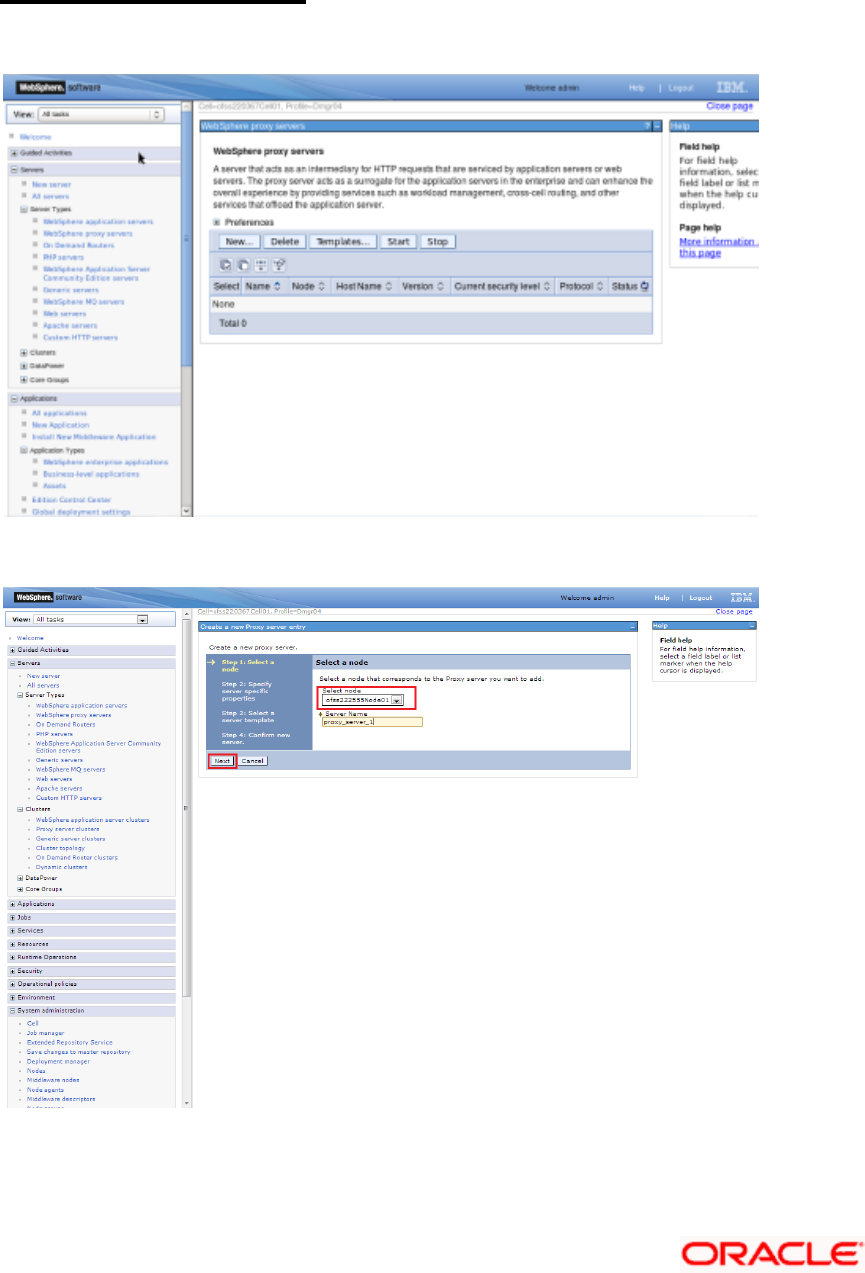
4-21
4.4 Create Proxy Server
Navigation : Servers > Server Types > WebSphere proxy servers > New
Navigation : [Select appropriate Node] > Next

4-22

4-23

4-24
4.4.1 Start Proxy Server

4-26
4.5.1 Virtual Host Setup
Navigation : Environment>Virtual hosts>proxy_host

4-27
Navigation : Host Aliases
Navigation : Environment>Virtual hosts>proxy_host>Host Aliases > New

4-28
Create New Alias for default port in managed server <<9081>>:
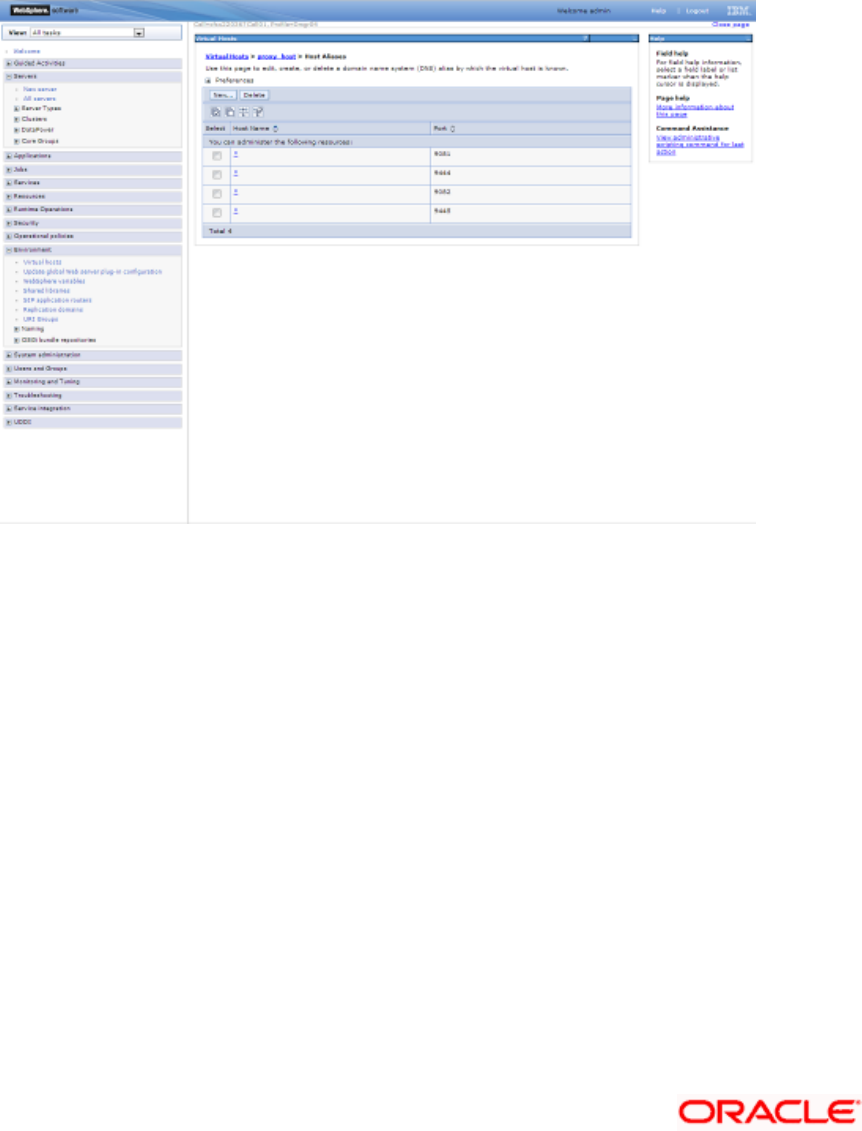
4-29
Similarly create proxy alias for all cluster related server default ports

5. Create Resources in Cluster Scope
JDBC Provider :
Datasource :

5-2
Queue Connection Factory
JMS Queue:

5-4

6. Deploy Application to Cluster
While deploying ensure the application is installed to Cluster
Start FCUBS application

6-2
6.1.1 Test the application
Make a note of the ports PROXY_HTTPS_ADDRESS/ PROXY_HTTP_ADDRESS to access the application.
Navigation : Servers > Server Types > WebSphere proxy servers > [proxy_server_1] > Ports
Launch Application:
URL : http://<host>:<PROXY_HTTP_ADDRESS>/FCJNeoWeb or
https://<host>:<PROXY_HTTPS_ADDRESS>/FCJNeoWeb

6-3

Cluster Creation on Websphere
[June] [2021]
Version 14.5.1.0.0
Oracle Financial Services Software Limited
Oracle Park
Off Western Express Highway
Goregaon (East)
Mumbai, Maharashtra 400 063
India
Worldwide Inquiries:
Phone: +91 22 6718 3000
Fax: +91 22 6718 3001
https://www.oracle.com/industries/financial-services/index.html
Copyright © [2007], [2021], Oracle and/or its affiliates. All rights reserved.
Oracle and Java are registered trademarks of Oracle and/or its affiliates. Other names may be trademarks of their respective owners.
U.S. GOVERNMENT END USERS: Oracle programs, including any operating system, integrated software, any programs installed on
the hardware, and/or documentation, delivered to U.S. Government end users are "commercial computer software" pursuant to the
applicable Federal Acquisition Regulation and agency-specific supplemental regulations. As such, use, duplication, disclosure,
modification, and adaptation of the programs, including any operating system, integrated software, any programs installed on the
hardware, and/or documentation, shall be subject to license terms and license restrictions applicable to the programs. No other
rights are granted to the U.S. Government.
This software or hardware is developed for general use in a variety of information management applications. It is not developed or
intended for use in any inherently dangerous applications, including applications that may create a risk of personal injury. If you
use this software or hardware in dangerous applications, then you shall be responsible to take all appropriate failsafe, backup,
redundancy, and other measures to ensure its safe use. Oracle Corporation and its affiliates disclaim any liability for any damages
caused by use of this software or hardware in dangerous applications.
This software and related documentation are provided under a license agreement containing restrictions on use and disclosure and
are protected by intellectual property laws. Except as expressly permitted in your license agreement or allowed by law, you may not
use, copy, reproduce, translate, broadcast, modify, license, transmit, distribute, exhibit, perform, publish or display any part, in any
form, or by any means. Reverse engineering, disassembly, or decompilation of this software, unless required by law for
interoperability, is prohibited.
The information contained herein is subject to change without notice and is not warranted to be error-free. If you find any errors,
please report them to us in writing.
This software or hardware and documentation may provide access to or information on content, products and services from third
parties. Oracle Corporation and its affiliates are not responsible for and expressly disclaim all warranties of any kind with respect to
third-party content, products, and services. Oracle Corporation and its affiliates will not be responsible for any loss, costs, or
damages incurred due to your access to or use of third-party content, products, or services.




